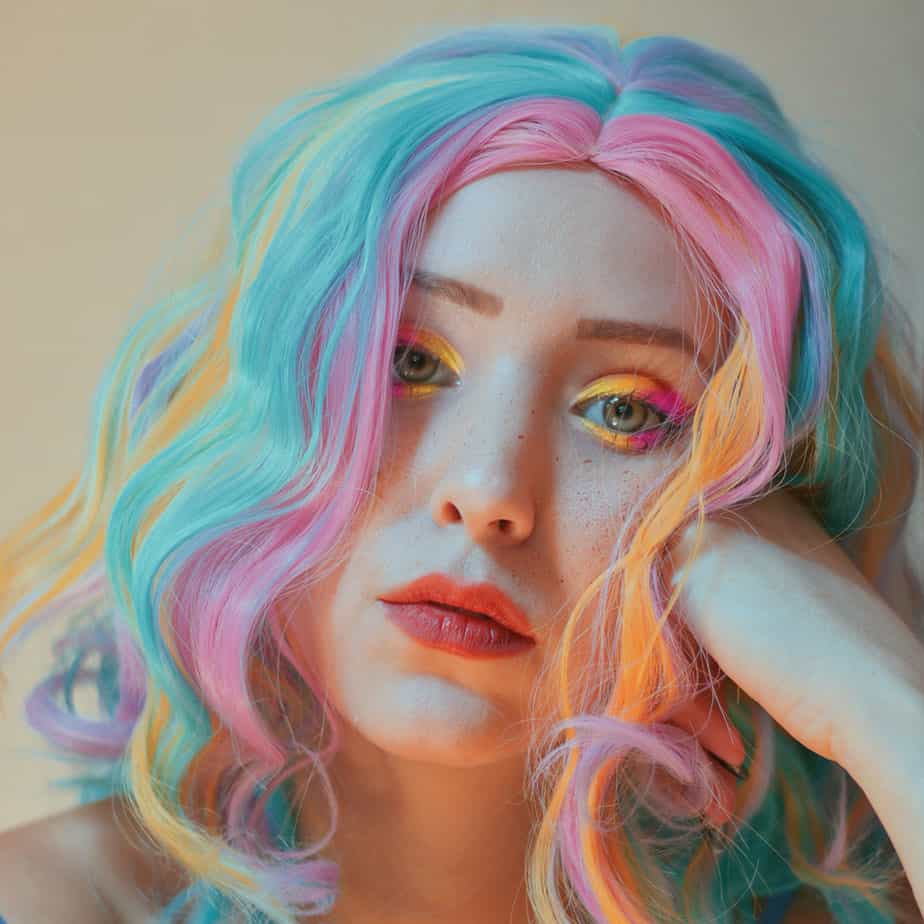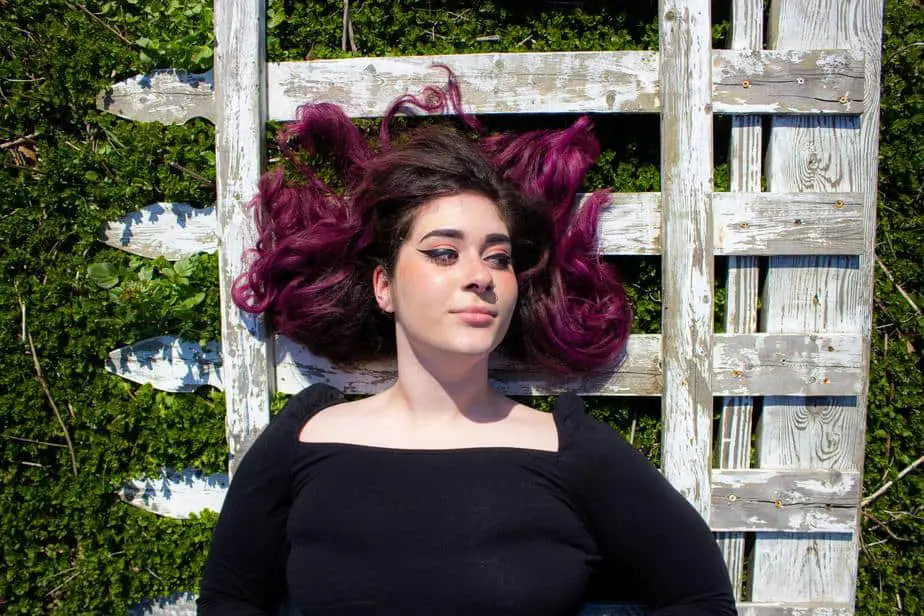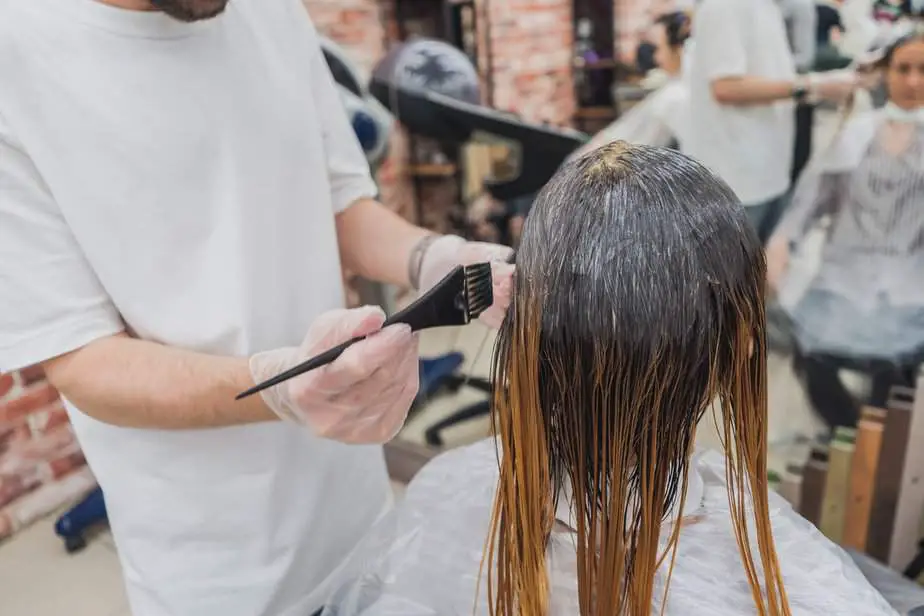You are very smart for asking this question before accepting an invite to a friend’s pool party even though you dyed your hair recently, because it would have ended in a disaster. Not only would your hair stylist’s hard work on your hair be undone (and your money wasted), but you would be left with discolored hair and your friend would be left with a discolored pool.
Unfortunately, a lot of people make the mistake of going straight to the pool or ocean after dyeing their hair. They think it’s fine because it’s likely that the hair stylist has already rinsed their hair with water and so they assume that they can now expose their hair to pool or salt water as well. That couldn’t be further from the truth; your newly dyed hair is not ready to be exposed to chlorine or salt!
If you just recently dyed your hair, do not expose it to pool or saltwater. The chemicals used to sanitize pool water, particularly chlorine, will oxidize the hair pigment and cause color runs. Similarly, saltwater can enter the hair cuticle, penetrate all the way to the hair shaft, and pull the dye out. Both chlorine and saltwater can also dry your hair out by stripping it of its oils, which can damage your hair. You should wait at least 3-7 days after dyeing your hair before you go to the pool or ocean.
If you keep reading on, we will discuss how saltwater and pool water damages your hair and how you can protect your dyed hair from chlorine.
How soon can I swim after coloring my hair?
If your hair stylist hasn’t told you, there are many rules of hair maintenance after dyeing your hair. If it’s summertime, you will likely feel the urge to go to the pool, but then that would expose your dyed hair to chlorine which can ruin your hair. You need to wait for some time so that the hair dye can settle into your hair, and how long you must wait depends on the type of hair dye used.
Semi-permanent hair dye
If your hair was dyed with semi-permanent dye, you don’t have to wait as long before you can join your friends at the pool party or beach. It is recommended you wait a full 72 hours (3 days) to allow the dye to set in before exposing your hair to chlorine or salt.
Since semi-permanent hair dye uses less chemicals than permanent hair dye, the waiting period is thankfully less. However, you can double check with your hair stylist about the details of the dye used before you cannon ball into the deep end of a pool. When you surface, you might not like what you see.
Permanent hair dye
Whether you got balayage, highlights, or your entire hair dyed a different color, permanent hair dye cannot be exposed to chlorine for at least 168 hours (a week). This means that if you got your hair dyed on a Monday, don’t even think about going to the pool until next Monday.
Why do you have to wait so long after dyeing your hair with permanent dye? The reason is that more chemicals, such as hair developer, are needed in permanent dye so that it can truly permanently dye your hair. Otherwise, your hair color might start to lose its luster and even begin to fade.
Unfortunately, these chemicals can potentially have an undesirable reaction with chlorine which could prevent them from setting on your hair. Just to be safe, a one week waiting period is recommended so that as much time is given for these chemicals to get absorbed into your hair so that not even chlorine or salt can get them out.
Why did my dyed hair run in the pool?

You don’t want to pay the big bucks for a fancy color treatment for your hair only for it to immediately get ruined at a pool party. It’s not that the salon did a bad job, but rather you didn’t wait long enough for the treatment to set in. Here are some of the most common reasons for dyed hair to run or change color.
You didn’t wait long enough
Look, we did tell you to wait 3-7 days after dyeing your hair before going to the pool. These are minimum times, meaning you are still cutting it close by going to the pool that quickly. It’s possible that, depending on the chemicals used in the dye, that slightly more time was required for it to dye your hair. In essence, you didn’t wait long enough.
Summer quickly comes and goes, so we don’t want to tell you to waste your precious summer days waiting around, not being able to hang out with your friends at the pool. That said, consider dyeing your hair before summer is in full swing so that you don’t waste any summer days.
Also, you can still go to the pool party or beach. However, what we are saying is that you shouldn’t enter the water. However, if you know that you cannot escape the allure of water, then you had best not go to these parties because you might forget that you shouldn’t get wet.
You didn’t rinse your hair after dyeing
When you first wash your hair with fresh water after dyeing it, a lot of color will run out. This is normal, and the hair stylist will likely do this for you at the salon to monitor if there are any issues before presenting you with the final look.
When you’re dyeing hair at home, you will have to rinse your own hair afterwards. Again, expect some of the dye to run, and be prepared for stains in your shower stall and clothing (hopefully you weren’t wearing your nice clothes).
If you go to the pool after having your hair dyed recently, but before you had your first rinse, then it’s going to look like a lot of dye will run simply because it hasn’t gotten a chance to run yet. So just about the worst thing you can do after dyeing your hair is immediately going to the pool.
Does chlorine damage dyed hair?
Perhaps you’ve seen people with what you think was supposed to be blonde hair, whether natural or dyed, that is slightly green-tinted? You might have thought, why the heck did this person dye their hair slightly green? No, they didn’t dye it green; it’s what chlorine can do to blonde hair or any other hair color that is a light enough shade.
Thankfully, this is not as much of an issue with darker hair colors, such as red or purple hair. You will have a bigger issue with color run when exposed to water, but once these dyes have set, then you don’t have to worry about the colors changing when exposed to chlorine.
The biggest risk if your hair is dyed a darker color is, again, exposing your hair to chlorine before it has had a chance to set. It will be immediately obvious that you botched your dye job if large portions of your hair has had a color run.
Additionally, chlorine has other negative effects other than ruining color treated hair. It can strip your hair of its natural oils, leaving it unprotected and exposed to the elements. This can result in brittle and dried hair and loads of split ends. In general, chlorine is bad for your hair, but if you know how to protect your hair, then its damaging effects can be minimized.
How to protect color-treated hair from chlorine

All of these tips should be done after you’ve waited out the minimum time of 3-7 days we suggested. These tips are not intended to protect dyed hair from losing its color immediately after having your hair dyed.
Add a layer of oil to your hair
Chlorine strps your hair of its natural layer of oil, which causes it to dry out. Salt does the same thing and will absorb moisture from your hair. Whether you’re planning on going to the pool or beach, consider adding an extra layer of oil to your hair.
Since oil and water repel each other, a great way to lock in moisture in your hair is to apply a moisturizing oil, such as argan oil or Morrocan oil. This, too, will eventually get stripped by salt water and chlorinated water. But, it will allow you to spend more time in the water while protecting your hair. This can also protect your hair color from fading.
Moisturize your hair
If you don’t have any moisturizing oil or any product at all to protect your hair, at a minimum you can still moisturize your hair. By running fresh water on your hair until it has become fully saturated with water, you prime your hair such that it is less likely to dry out so fast.
Your saturated hair will not absorb as much chlorinated water which limits the amount of damage chlorine can do to your hair and its dye.
Tie your hair up
If you have long hair, you do not want it floating everywhere and possibly getting snagged on something. Tying your hair up is therefore a very practical safety tip. What’s more, it can also protect your hair.
When your hair is bundled up, the hair on the outside forms somewhat of a protective layer for the hair bundled up inside, limiting the amount of exposure to chlorine, saltwater, or UV rays. It also keeps your hair from getting tangled up and getting painfully yanked which can damage it. It also lends itself nicely to the next piece of advice we have.
Wear a swim cap
If you actually plan on swimming laps, we highly recommend you wear a swim cap to protect your hair. While the purpose of the swim cap is to make your head shape more hydrodynamic, it also has a side benefit of limiting the amount of chlorine your hair is exposed to.
There is a misconception that a swim cap will keep your hair completely dry; it won’t, but just restricting how much water can reach your hair, as well as keeping it packed down tightly, makes it less likely for your dyed hair to get damaged by chlorine.
Parting words
Hair dye and water don’t mix well. In the days following dyeing your hair, you must be very careful about what you expose your hair to. Unfortunately, you cannot participate in any pool or ocean activities because the water will ruin your hair. That said, you can still go to a pool party or the beach; you just can’t enter the water.
We recommend waiting at least 3 days if your hair was dyed using semi-permanent dye, and at least 7 days (1 week) if your hair was dyed with permanent dye. If you’re unsure, you can wait a bit longer just to be safe.
As long as you wait out the allotted time patiently, you can then safely resume your normal pool or beach routine without worrying about ruining your new hair color. If you got your hair dyed by a hair stylist, ask them what their recommendations are regarding how to protect your hair in your daily life. In the water, you can moisturize your hair, add oil to it, tie it up, and wear a swim cap.
If you are paranoid about chlorine ruining your hair by turning it green or some other color, perhaps wait until winter to dye your hair.


